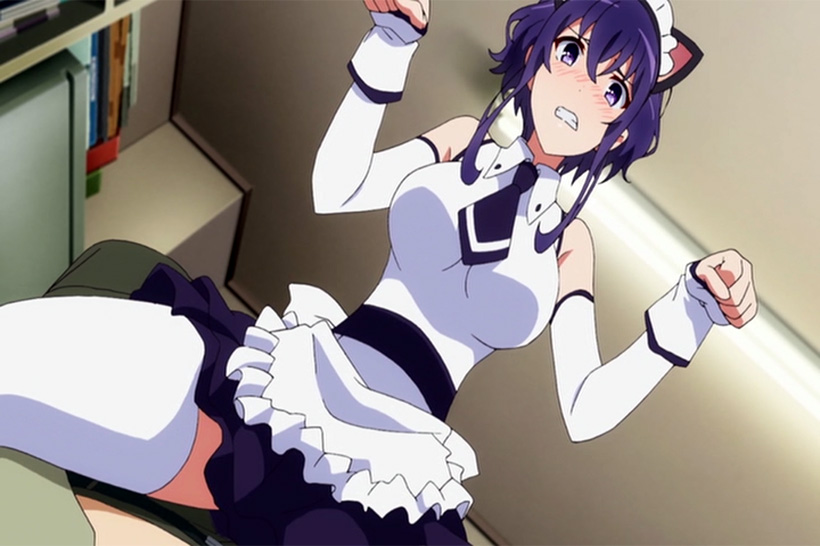Obstinately proud otaku Tomoya Aki believes that it’s his duty to share with the world the abundance of light novels, manga, anime, and games that are available. Having converted many of his peers to otakuism, coupled with running an incredibly popular blog based around these interests, it’s safe to say that he is most definitely a pioneer of otaku culture. While content with being a consumer, Tomoya encounters Megumi Kato after her beret is carried off in a breeze filled with cherry blossoms. The sheer amount of clichéd romance that this moment exuded causes Tomoya to become obsessed with creating a dating sim stemming from the experience. Saekano follows Tomoya as he enlists the help of his otaku classmates, working together to realise his dream.
With such a title, Saekano: How to Raise a Boring Girlfriend is almost guaranteed to be amazing from the outset. It’s clear from the first episode what is to be expected from the series, yet I was pleasantly surprised at the apparent lack of the use of tropes that the ecchi genre is known and watched for. As to be expected, eventually the show leads into non-stop panning shots of the scantily clad female characters’ bodies, but until that point, about half-way through, the story and characters seemed genuine. The humour remains strong throughout the show, however, and received a few audible scoffs from me. Being mostly self-deprecating and unpredictable, with plenty of sexual innuendos thrown in, I can wholeheartedly appreciate Saekano as a comedy.

With blatant references to popular anime such as Sword Art Online and Gurren Lagann, there’s an evident audience that is catered for. Saekano is, without a doubt, a fun show not to be taken seriously at all, which seems to be a recurring theme in the last few reviews that I’ve written. There are a several moments where the fourth wall is broken, but done so in a way that isn’t cringey and somehow remains appropriate. To elaborate, there’s one scene towards the end of the show where a very minor character who hasn’t appeared since the beginning comes in to act solely as a plot device. This fact is made obvious by the main character stating how he hasn’t seen him in “ten episodes”. The matter-of-fact way in which the characters say these lines leads to some hilarious deadpan humour.
Although nothing spectacular, the story presented throughout the show is engaging. I found myself genuinely interested in the characters’ progression in face of all the chaotic “drama” that was thrown their way. Of course, the highlight of Saekano is the comedy, but I doubt it would be as entertaining had it not built the jokes off of the story. I personally would have preferred if less time was spent on all of the female characters literally pushing themselves onto the sole male protagonist, but I can at least appreciate the show despite this. Even still, too many moments where massive headway is being made on the plot and meaningful development is occurring between characters were ruined when the current female on screen begins to uncontrollably orgasm irrationally.

The idea of a geeky high school student pursuing game development isn’t very far-fetched. As such, it’s the characters which truly make this anime one wacky adventure. Furthering the comedic side of the show, the fact that Saekano is an anime is constantly referenced and made fun of. Specfically, the idea that each character represents a common archetype found in Japanese media is often pointed out in the most obvious ways, or, in Megumi’s case, the fact that she is completely one-dimensional is focused on instead. Megumi was a character I initially underappreciated, but amongst the other female characters in the show she provided some much needed regularity to the lineup. Her unconcerned attitude accentuates the personalities of the other characters in a positive way, and I honestly think that the show would be complete trash without her.
There’s not much to say about Tomoya; he’s really just there to take the brunt of the sexual harassment. The ones doing the harassing, though, are so ridiculous that it’s hard to take them seriously. As the actual creative members of the team, Eriri Spencer Sawamura and Utaha Kasumigaoka are also incredibly successful outside of school. Eriri, who is a famous adult-oriented doujinshi maker, is in charge of the art assets for the game. Utaha, as the recently emerged author of a romance light novel that has sold over 500,000 copies, is, of course, responsible for the story. Although it’s beyond unrealistic for two high school girls to have amassed such fame, it does lead to some fun interactions. However, I do worry that the most sexually forward character in the show ends up being Tomoya’s cousin, but that’s just one of many questionable directions that Saekano takes.

Saekano has a crazy and a surprisingly down to earth cast of characters and plot with the only thing letting it down being the ecchi label. It’s a show that knows exactly what it is, and uses that to its advantage, but it has the potential to be so much more. I’m honestly torn in my opinion. If Saekano played out how I originally expected, focused solely on the objectification of young anime girls, then I could easily have moved on. However, the first half of the show led me to believe that the naked ladies were sparse, if at all present, and it didn’t rely heavily on sexual content as a crutch to lure a single demographic in. It had all the trappings of an accessible comedy that made use of some adult and meta humour, but unfortunately made a sharp u-turn back into hard ecchi territory.

I could go on forever about the good and bad of Saekano, but I can’t stress enough that the huge focus on the ecchi aspect of the show probably alienated some viewers. Not to say that it isn’t a popular show, as it’s evident that enough people enjoyed it for there to be a second season, but I digress. It’s not the fact that it’s an ecchi which is detrimental to the show, it’s the fact that it almost wasn’t.
A review copy was provided by Madman Entertainment to the author for the purpose of this review.





